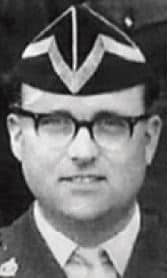Charles was born into a naval family. His father a regular sailor had been a submarine commander in the last war and his grandfather had risen to Admiral’s rank, an achievement celebrated by images hung in Charles’s cloakroom.

After Eton,Charles was destined for Christchurch and a different career but his father balked at the cost and steered Charles towards Sandhurst.
Commissioned into the 4th Queens Own Hussars in 1954 he joined a lively group of young officers. As Charles would say, being of the same age as Brian Kenny rather put paid to his chance of commanding the Regiment but there was no doubt about Charles’s ability as a soldier.
He thoroughly enjoyed the 4th Hussars and the congenial life at Hohne in Germany. He had strong views about the proper conduct of officers. At his first mess night, seated as of the right but some diffidence next to the Colonel, he was approached by the mess sergeant offering sherry; Charles demurred and was immediately silenced by the reproof “4th Hussars officers always drink sherry sir” and given a bucket full to prove it.
He approved of such custom and was sharply critical of over demonstrative and insensitive behaviour. On joining he immediately bought a hunter, described as wild eyed, fleet footed and with a mouth of iron which carted him at speed around various hunter trials and out with the Wessex Hounds.
After four years he joined the Aden Protectorate Levies which gained him some valuable experience and enabled him, as he said, to refresh his wardrobe on his return.
He did not stay long with the Regiment, by now the Queens Royal Irish Hussars, in moving to Fontainebleau as ADC to the C-in C Allied Land Forces Europe and then on to act as Adjutant to the North Irish Horse.
There he met and married Anna. Staff College followed in 1964 and his first staff appointment with the HQ Land Forces Persian Gulf in Bahrain.
In 1969 he returned to the Regiment as Squadron Leader ‘C’ Sqn in Wolfenbuettel and Bovington and was then instructed at Staff Colleges at Warminster and Camberley and the National Defence College.
Conscious of the need to educate his three daughters and find a more settled existence Charles left the Army in 1979 and joined a firm of consultants acting in the personnel field. As such he was approached by several brother officers seeking fresh careers, some of whom he categorised as unemployable.
He did not find commercial life so attractive as to prevent him shortly afterwards returning to Eton as one of the assistant bursars. This provided him with much enjoyment in seeing Eton life from a different aspect and attempting to introduce some military rigour into aspects of the system which he considered ineffective. T
o his great pleasure, he was asked by the Provost to take on the supervision of the College beagle pack and the ensuring visits to a number of noble seats supplied him with many happy recollections.
From Eton he moved, in his final employment, to Downe House, again as Bursar a role which suited both his daughter’s education and his pocket. A characteristic of Charles engagement with the educational establishment was his tussles with senior figures in the field.
Having coped more than adequately with the institution for which he was trained he was not going to be over impressed by authority in a different hierarchy and there is no doubt he left his mark on the head teachers at both schools.
Retirement to Devon followed and a busy life in local affairs working with the church, the neighbouring school and the National Trust. His cultural interests were wide, particularly in music and he had a passion for sailing all his life.
Perhaps inspired by some inherited gene he owned a number of boats and from childhood spent what time and possibly more money than he could afford on the water.
All in all we have lost a distinctive and memorable personality, a more than capable soldier and a man loyal to his many friends who will cherish his memory.


